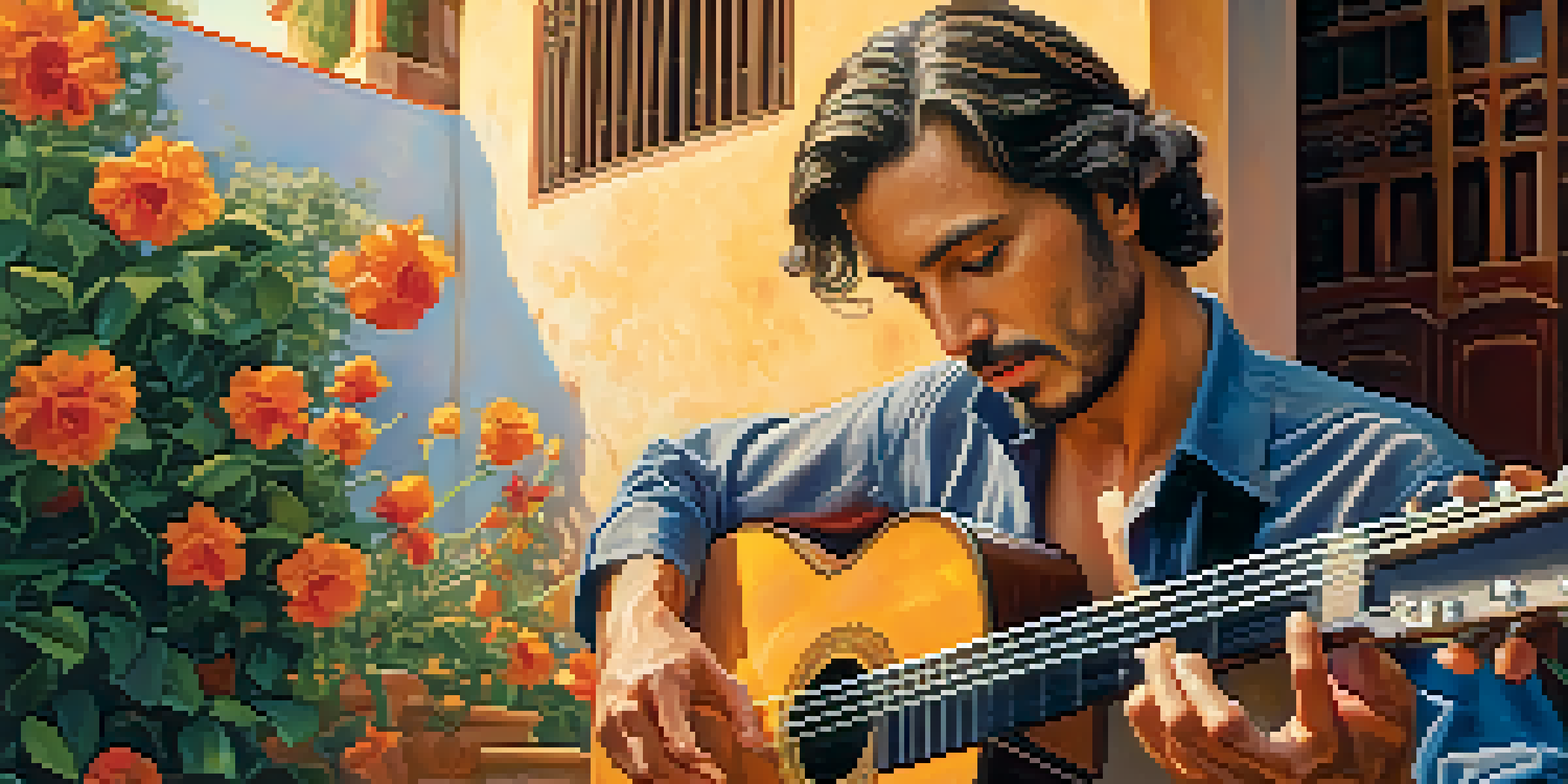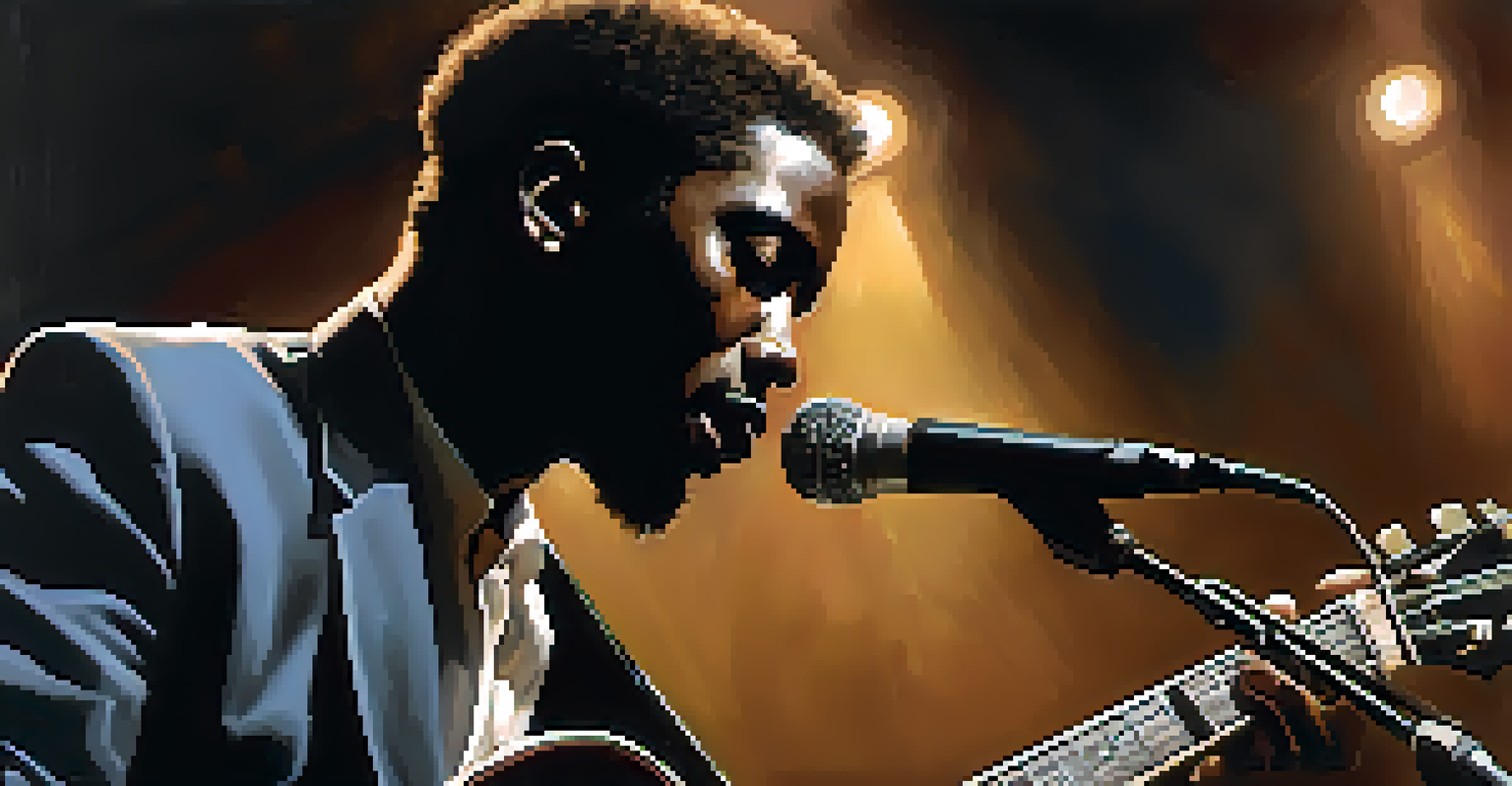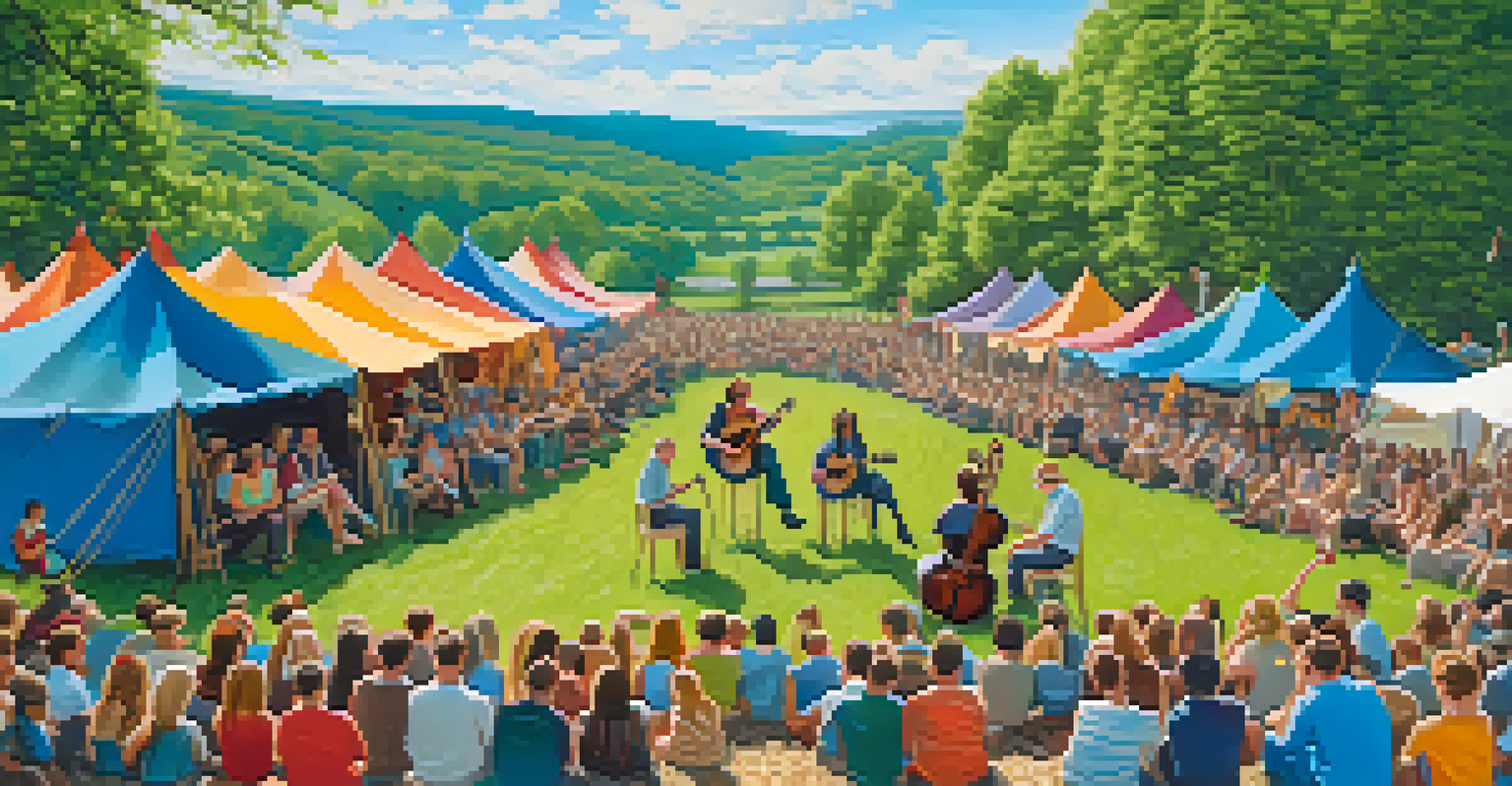Cultural Identity Expressed Through Guitar Playing Styles

Understanding Cultural Identity in Music
Cultural identity encompasses the shared characteristics and values of a group, often expressed through art and music. When it comes to guitar playing, various styles emerge as reflections of cultural heritage and personal experiences. For instance, the strumming patterns of Flamenco guitar are deeply rooted in Spanish traditions, showcasing a vibrant cultural narrative.
Music can change the world because it can change people.
Moreover, the way musicians play the guitar can reveal much about their geographic and social backgrounds. From the bluesy riffs of Southern American music to the intricate melodies of Indian classical guitar, each style tells a unique story about its origins. These expressions not only celebrate cultural diversity but also foster connections between different communities.
In essence, guitar playing becomes a medium through which cultural identity is articulated. Musicians often blend techniques from different styles, creating new sounds that reflect their multifaceted identities. This blending exemplifies the dynamic nature of cultural expression, showing that identity is not static but continually evolving.
The Blues: A Story of African American Heritage
The Blues is more than just a genre; it's a powerful expression of African American cultural identity. Originating in the Deep South, it emerged from a history of struggle and resilience. The distinctive guitar licks and soulful melodies often convey deep emotions, reflecting the lived experiences of the community.

Artists like B.B. King and Muddy Waters showcased techniques such as bending notes and fingerpicking, which became staples of the blues guitar style. These techniques not only highlight musical skill but also serve as a storytelling device, conveying messages of heartache, hope, and triumph. Each strum and slide tells a part of the African American narrative.
Cultural Identity Expressed Through Guitar
Guitar playing serves as a powerful medium for cultural identity, showcasing unique styles that reflect personal and community narratives.
The influence of blues can be seen across various genres, from rock to jazz, illustrating how cultural identity shapes music. This connection to heritage continues to inspire new generations of musicians, who carry the torch while adding their personal flair. The Blues remains a testament to the enduring spirit of a culture that thrives through music.
Flamenco Guitar: The Heartbeat of Spanish Culture
Flamenco guitar is a vibrant expression of Spanish culture, particularly from the Andalusian region. Characterized by its intricate fingerpicking and rhythmic strumming, it embodies the passion and intensity of Flamenco dance. The emotional connection between the guitarist and dancer is palpable, creating a unique cultural experience.
The music we listen to, the music we create, and the music we share can be a reflection of who we are and where we come from.
The history of Flamenco is rich, rooted in the convergence of various influences, including Gypsy, Moorish, and Andalusian traditions. Each performance tells a story, often reflecting themes of love, struggle, and celebration. Through the guitar, musicians convey the essence of their cultural identity, allowing audiences to feel the depth of their emotions.
Moreover, Flamenco guitarists often innovate within the tradition, incorporating modern elements while respecting its heritage. This blend showcases the dynamic nature of cultural identity, as artists navigate their roots while exploring new musical landscapes. As such, Flamenco remains a living tradition, continuously evolving and touching hearts around the world.
Classical Guitar: A European Legacy
Classical guitar embodies a rich European tradition, characterized by its refined techniques and intricate compositions. Originating from Spain and spreading throughout Europe, this style emphasizes fingerstyle playing, allowing for a wide range of expression. The music often draws from historical influences, including Baroque and Romantic periods, showcasing the evolution of cultural identity.
Renowned composers like Francisco Tárrega and Andrés Segovia played pivotal roles in popularizing classical guitar, elevating it to concert status. Their compositions not only highlight technical prowess but also reflect the cultural nuances of their time. Through their work, classical guitarists maintain a connection to European heritage while inspiring contemporary musicians.
Blues: A Reflection of Heritage
The Blues genre embodies African American cultural identity, conveying deep emotions and stories through its distinctive guitar techniques.
In today’s world, classical guitar continues to thrive, with artists blending traditional and modern influences. This adaptability reflects the ongoing dialogue between past and present, allowing cultural identity to flourish. Ultimately, classical guitar serves as a bridge, connecting diverse audiences through its timeless beauty and emotional depth.
Celtic Guitar: Echoes of Ireland and Scotland
Celtic guitar captures the essence of Irish and Scottish folk traditions, rich in storytelling and community spirit. The use of fingerstyle techniques and alternate tunings creates a distinctive sound that resonates with the heart of Celtic culture. Songs often celebrate nature, history, and mythology, making guitar playing an integral part of cultural expression.
Artists like John Doyle and Pierre Bensusan have brought Celtic guitar to the forefront, showcasing its versatility and melodic richness. Their music often features intricate arrangements that highlight the interplay between melody and harmony, inviting listeners into a world steeped in tradition. This connection fosters a sense of belonging and pride in cultural heritage.
Furthermore, the rise of folk festivals and gatherings has revitalized interest in Celtic guitar, encouraging new musicians to explore this rich tradition. As modern influences merge with traditional sounds, Celtic guitar continues to evolve, reflecting the dynamic nature of cultural identity. This ongoing journey illustrates how the past informs the present, creating a vibrant tapestry of musical expression.
Rock Guitar: A Voice of Rebellion and Identity
Rock guitar emerged in the mid-20th century as a potent symbol of youth culture and rebellion. With its powerful riffs and electrifying solos, it became a voice for a generation seeking to express their identity and defy societal norms. Iconic guitarists like Jimi Hendrix and Eric Clapton not only showcased technical skill but also captured the essence of cultural movements.
The raw energy of rock music often reflects the struggles and aspirations of its listeners, making it a powerful tool for cultural expression. From the anthems of the 1960s counterculture to the grunge movement of the 1990s, rock guitar remains a canvas for artists to convey their messages. This connection fosters a sense of community among fans, uniting them through shared experiences.
Innovation in Traditional Music
Musicians are blending traditional and modern influences in genres like Flamenco and Celtic guitar, illustrating the evolving nature of cultural expression.
As rock continues to evolve, it embraces influences from various genres, reflecting the diversity of cultural identity. Today’s guitarists blend rock with elements of hip-hop, country, and electronic music, creating new sounds that resonate with contemporary audiences. This adaptability showcases the enduring relevance of rock guitar as a means of cultural expression.
World Music: Fusion and Global Identity
World music encompasses a broad range of genres from various cultures, often characterized by the fusion of traditional and contemporary styles. Guitarists around the globe blend different musical elements, creating innovative sounds that reflect their unique cultural identities. This cross-pollination fosters a rich tapestry of musical expression, celebrating diversity.
For instance, the incorporation of African rhythms into Western pop guitar has birthed exciting new genres, highlighting how cultural exchange can lead to creative growth. Artists like Tinariwen and Rodrigo y Gabriela exemplify this fusion, combining traditional techniques with modern influences to create fresh sounds. Their music resonates with audiences worldwide, bridging cultural divides.

In this era of globalization, the guitar serves as a universal language, connecting people from diverse backgrounds. Musicians continue to explore and experiment, pushing boundaries while honoring their roots. This ongoing journey illustrates the dynamic nature of cultural identity, as artists navigate their unique paths while contributing to a global musical dialogue.
The Future of Guitar Playing and Cultural Identity
As we look to the future, the role of guitar in expressing cultural identity will undoubtedly continue to evolve. With advancements in technology and the rise of social media, musicians have unprecedented access to global influences and audiences. This interconnectedness encourages guitarists to explore new styles and collaborate across borders, enriching their cultural narratives.
Emerging artists are increasingly blending genres and experimenting with sounds, creating innovative approaches to guitar playing. This exploration not only reflects personal identity but also fosters a sense of community among diverse musical traditions. As cultural identities continue to intertwine, the guitar remains a vital tool for expression and connection.
Ultimately, the future of guitar playing promises to be as dynamic and diverse as the cultures it represents. By embracing innovation while honoring tradition, musicians can keep cultural identities alive and thriving. As they share their stories through the universal language of music, the guitar will continue to resonate with audiences across the globe.